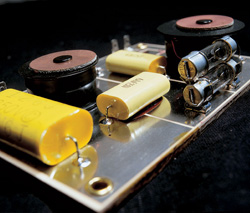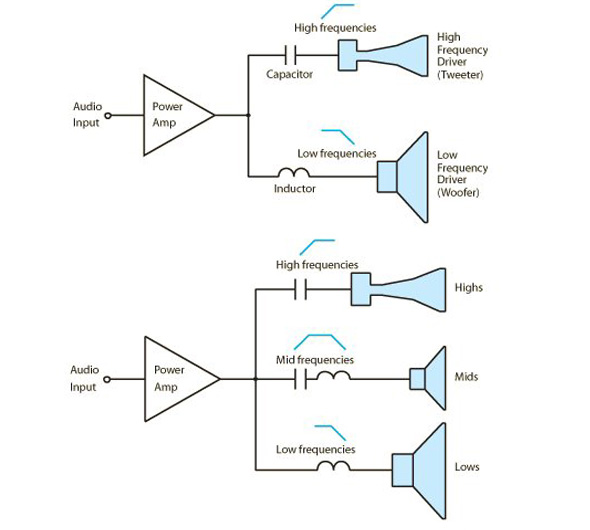
Crossovers: Simple Division
Loudspeaker crossovers are a necessary evil. A different universe, a different set of physics and maybe we could have what we want: one loudspeaker that does it all.
One loudspeaker that reproduces all audio frequencies equally well, with no distortion, at loudness levels adequate for whatever venue we play.
Well, we live here, and our system of physics does not allow such extravagance. The hard truth is, no one loudspeaker can do it all.
We need at least two—more if we can afford them. Woofers and tweeters. A big woofer for the lows and a little tweeter for the highs. This is known as a 2-way system. (Check the accompanying diagrams below for the following discussions.)
But with two speakers, the correct frequencies must be routed (or crossed over) to each loudspeaker.
Passive
At the simplest level a crossover is a passive network. A passive network is one not needing a power supply to operate—if it has a line cord, or runs off batteries, then it is not a passive circuit.
The simplest passive crossover network consists of only two components: a capacitor connecting to the high frequency driver and an inductor (aka a coil) connecting to the low frequency driver.
A capacitor is an electronic component that passes high frequencies (the passband) and blocks low frequencies (the stopband); an inductor does just the opposite: it passes low frequencies and blocks high frequencies.
But as the frequency changes, neither component reacts suddenly. They do it gradually; they slowly start to pass (or stop passing) their respective frequencies. The rate at which this occurs is called the crossover slope.
It is measured in dB per octave, or shortened to dB/octave. The slope increases or decreases so many dB/octave. At the simplest level, each component gives you a 6 dB/octave slope (a physical fact of our universe).
Again, at the simplest level, adding more components increases the slope in 6 dB increments, creating slopes of 12 dB/oct, 18 dB/oct, 24 dB/oct, and so on.
The number of components, or 6 dB slope increments, is called the crossover order. Therefore, a 4th-order crossover has (at least) four components, and produces steep slopes of 24 dB/octave.
The steeper the better for most drivers, since speakers only perform well for a certain band of frequencies; beyond that they misbehave, sometimes badly. Steep slopes prevent these frequencies from getting to the driver.
You can combine capacitors and inductors to create a third path that eliminates the highest highs and the lowest lows, and forms a mid-frequency crossover section. This is naturally called a 3-way system. (See diagram)
The “mid” section forms a bandpass filter, since it only passes a specific frequency band. Note from the diagram that the high frequency passband and low frequency passband terms are often shortened to just high-pass and low-pass.
A 3-way system allows optimizing each driver for a narrower band of frequencies, producing a better overall sound. So why not just use passive boxes?

